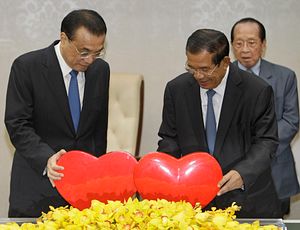This year marks the 60th anniversary of the establishment of diplomatic ties between Cambodia and China. Chinese Premier Li Kequiang visited Cambodia earlier this year and oversaw the signing of 19 new deals to celebrate this milestone.
The 19 bilateral memoranda of understanding (MoUs) and agreements reached by both countries signify the deepening of Sino-Cambodian relation, further entrenching China’s presence in the Southeast Asian country — to the apprehension of many. However, the deals also represent an opportunity for Cambodia to build much-needed infrastructure and develop its industries to compete in regional and global markets.
Cambodia’s further embrace of China is not without reason. One of China’s closest allies in Southeast Asia, Cambodia’s ‘subservience’ is strategic, supporting both the current regime of Prime Minister Hun Sen and the development of the country. Amid dwindling support from the West, China has been a willing patron to front the Cambodian government’s industry and infrastructure projects. Last year, China provided nearly 30 percent of investment capital; this trend is likely to continue.
Cambodia is unlikely to receive any further funding from the European Union and the United States after it dissolved the country’s main opposition party, the Cambodian National Rescue Party (CNRP), shut down independent newspapers and radio stations, and kicked out civil society organizations. The dissolution of the CNRP effectively cemented Hun Sen’s mandate for another four years ahead of this year’s general national election. Both the EU and the United States have threatened to not recognize the election as legitimate without the participation of CNRP.
Unsurprisingly, this provided China with an opportune moment to reinforce its geopolitical position within Southeast Asia through Cambodia.
Many of the projects agreed to in the latest visit, such as the development of the Sihanoukville Special Economic Zone, the Phnom Penh-Sihanoukville Expressway, and the construction of a new airport in Phnom Penh, advance China’s Belt and Road Initiative (BRI). These noteworthy projects provide Cambodia with a solution to its aging, limited, and deteriorating infrastructure with the added benefit of being financially supported without major conditions.
Proponents of the deals point to the immense economic benefits of increased cooperation and trade between both countries; however, the Cambodian government should adopt a cautionary approach when binding itself to China.
China’s presence in Cambodia is nothing new. However, Cambodians should expect a major increase. The latest agreement aims for 2 million Chinese tourists to visit Cambodia and for bilateral trade to increase to $6 billion by 2020.
The coastal city of Sihanoukville, known for its beaches and Cambodia’s only deepwater port, has already undergone an immense transformation thanks to the increase in Chinese investments and citizens since 2013. Locals now dub the city Macau II, a nickname stemming from the proliferation of Chinese-operated casinos and Chinese citizens taking up residence. Estimates of the Chinese population range from the thousands to the tens of thousands in the city of 250,000.
Many Cambodians have profited from the injection of Chinese money, but locals are wary of the influx of China’s presence within the small city. The majority of new jobs are going to Chinese immigrants versus local Cambodians. Local businesses have also been hurt by the lack of Chinese tourists willing to go to Cambodian-owned establishments; they prefer to go to Chinese-owned establishments. Meanwhile, the influx of people and money has increased the costs of real estate and food.
The once quiet Sihanoukville is dotted with Mandarin signs and nonstop construction dominates the landscape. Cambodian tourists and Western visitors now opt for other cities like Kep and Kampot.
In response to the changing environment in Sihanoukville, the governor of Preah Sihanouk province, Yun Min, sent a three-page report last week to Interior Minister Sar Kheng outlining the grievances faced by local Cambodians. In the report, the governor highlights that the majority of foreigners requesting work permits are Chinese, representing 69 percent in the past year. Sensitive as the situation may be — Yun Min must serve the interests of Phnom Penh as well as his province — he recommends that relevant departments check work permits and collect statistics on foreign businesses.
This current situation in Sihanoukville is a small glimpse of what is to be expected when there are hardly any restrictions and regulations on foreign development.
What to do? Luckily, the current trend is reversible and can still be managed. Cambodia is strategic in accepting China’s monetary support, but its politicians also need to be strategic in how the vast resources are spent in developing industry and infrastructure. China has gained by advancing the core objectives of the Belt and Road Initiative. Phnom Penh needs to use China’s generosity to address complex issues facing Cambodia, such as reforming its education and healthcare sectors.
However, if it is unable to tackle these massive issues, Phnom Penh should first ensure that first and foremost Cambodians are employed, not only in the construction but also in the management of all projects. It is fundamental that Cambodians are given a chance to lead, instead of having to be led.
Second, these massive projects serve as an opportunity to ensure that development in Cambodia is integrated and sustainable, taking into account public transport, waste treatment, safe access to water, and sewage treatment. Cambodian politicians can employ regulations to help guide development, but the government has to ensure there is an effective monitoring mechanism in place.
Third, Cambodia can utilize China’s support and expertise to develop its local industries to ensure it meets international standards for exports. This will allow Cambodia to compete alongside its neighbors, Vietnam and Thailand.
Cambodia has already committed itself to a vision of turning cities like Phnom Penh and Sihanoukville into vibrant economic centers in Southeast Asia. The next step is becoming an active partner; otherwise, Cambodia risks allowing Chinese entrepreneurs and politicians take control as Cambodians sit on the sidelines.
Darren Touch is a Masters of Public Policy and Global Affairs Candidate at the University of British Columbia.

































